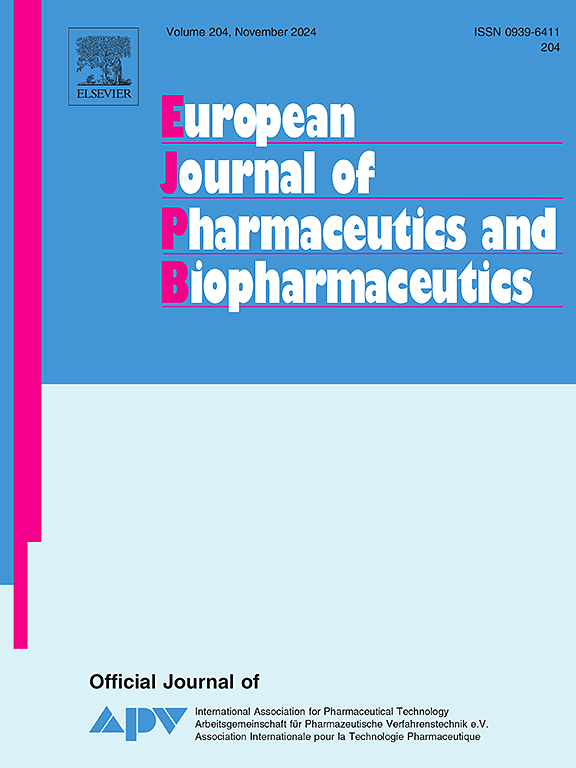FcRn-targeted Pluronic F127-Poly (L-lactic Acid) polymersomes for oral insulin delivery
IF 4.4
2区 医学
Q1 PHARMACOLOGY & PHARMACY
European Journal of Pharmaceutics and Biopharmaceutics
Pub Date : 2025-06-04
DOI:10.1016/j.ejpb.2025.114761
引用次数: 0
Abstract
The intestinal epithelium barrier is one of the main factors limiting the bioavailability of oral insulin delivery systems. Neonatal Fc (fragment crystallizable) receptor (FcRn) is highly expressed in the intestinal epithelium, which can bind specifically to the Fc fragments of IgG in a pH-dependent manner and thus improve the transepithelial transport of carriers modified by IgG Fc or Fc domain-binding peptides (FcBP) ligand. Thus, FcBP ligand was attached to Pluronic F127-polylactic acid polymersomes by using the biotin-avidin bridging technology to obtain FcRn-targeted FcBP-F127-PLA polymersomes. Insulin (INS) was loaded successfully into FcBP-F127-PLA with the loading efficiency of 12.01 %. The transepithelial transport experiments on Caco-2 cells using Coumarin-6 (C-6) as a fluorescence probe showed that the cumulative permeability percentage and apparent permeability coefficient (Papp) of the FcBP-F127-PLA/C-6 group was 1.7 and 1.8 times that of PLA-F127-PLA/C-6 group after 2 h of incubation, respectively. FcBP ligand density of FcBP-F127-PLA played a role on their transepithelial transport ability and 10%FcBP-F127-PLA with 10 % FcBP molar content was found to be the best. The in vivo hypoglycemic results showed that the relative pharmacological bioavailability (PAR%) of the oral 10%FcBP-F127-PLA/INS group was 43.6 %, which was 1.27 times that of the PLA-F127-PLA/INS group. Therefore, FcBP-F127-PLA polymersomes could be a promising carrier of the oral insulin delivery.

靶向fcrn的Pluronic F127-Poly (l -乳酸)聚合体用于口服胰岛素递送
肠上皮屏障是限制口服胰岛素给药系统生物利用度的主要因素之一。新生儿Fc(片段结晶)受体(FcRn)在肠上皮中高表达,可以ph依赖的方式特异性结合IgG的Fc片段,从而改善IgG Fc或Fc结构域结合肽(FcBP)配体修饰的载体的上皮转运。因此,利用生物素-亲和素桥接技术将FcBP配体连接到Pluronic f127 -聚乳酸聚合体上,获得fcrn靶向的FcBP- f127 - pla聚合体。胰岛素(INS)成功装载到FcBP-F127-PLA中,装载效率为12.01%。以香豆素-6 (Coumarin-6, C-6)为荧光探针对cco -2细胞进行经上皮转运实验,结果显示,孵育2 h后,FcBP-F127-PLA/C-6组的累积通透率和表观通透系数分别是PLA-F127-PLA/C-6组的1.7倍和1.8倍。FcBP- f127 - pla的fbp配体密度对其上皮转运能力有影响,其中10%FcBP-F127-PLA与10%FcBP摩尔含量的效果最好。体内降糖实验结果显示,口服10%FcBP-F127-PLA/INS组的相对药理生物利用度(PAR%)为43.6%,是PLA-F127-PLA/INS组的1.27倍。因此,FcBP-F127-PLA聚合体可能是一种有前景的口服胰岛素载体。
本文章由计算机程序翻译,如有差异,请以英文原文为准。
求助全文
约1分钟内获得全文
求助全文
来源期刊
CiteScore
8.80
自引率
4.10%
发文量
211
审稿时长
36 days
期刊介绍:
The European Journal of Pharmaceutics and Biopharmaceutics provides a medium for the publication of novel, innovative and hypothesis-driven research from the areas of Pharmaceutics and Biopharmaceutics.
Topics covered include for example:
Design and development of drug delivery systems for pharmaceuticals and biopharmaceuticals (small molecules, proteins, nucleic acids)
Aspects of manufacturing process design
Biomedical aspects of drug product design
Strategies and formulations for controlled drug transport across biological barriers
Physicochemical aspects of drug product development
Novel excipients for drug product design
Drug delivery and controlled release systems for systemic and local applications
Nanomaterials for therapeutic and diagnostic purposes
Advanced therapy medicinal products
Medical devices supporting a distinct pharmacological effect.

 求助内容:
求助内容: 应助结果提醒方式:
应助结果提醒方式:


